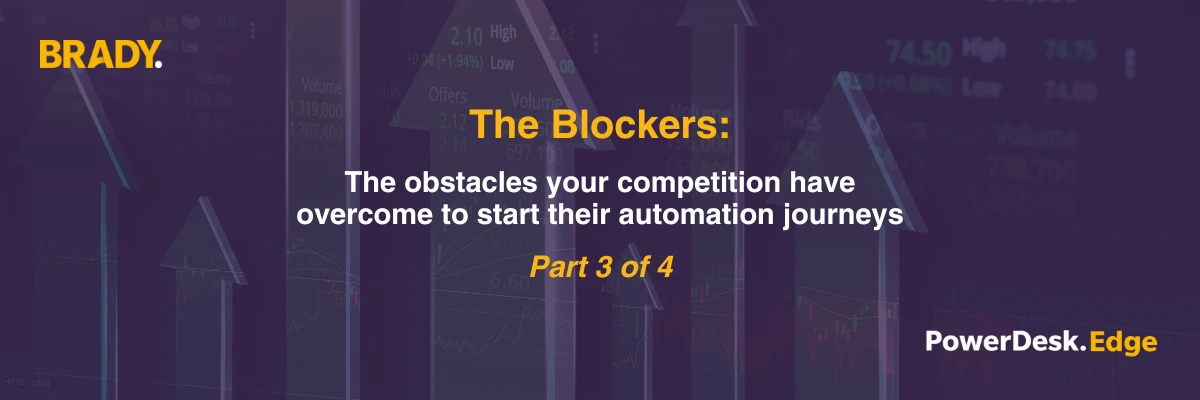The uncomfortable truth about your competition:
Every company successfully running algos today (your competitors capturing premium spreads while you sleep) started exactly where you are now. With the same doubts, blockers, and inertia.
The only difference?
They took the first step anyway.
In today’s blog entry:
We will expose what’s holding each type of trader back, according to the type of persona they fit into (see our previous blog entry in this series where we talked through who they are in more detail), and show you exactly how companies just like yours pushed through.
Why is this important now?
While you’re reading this, your competitors are automating. And every day you wait, the gap widens.
Persona 1: the independent asset owner’s blockers
Primary blocker: “this is too complex for us”
What it sounds like:
- “We’re a wind farm, not a trading desk”
- “We don’t have the technical expertise”
- “Algorithms are for big utilities with IT departments”
- “We’d need to hire developers and quants”
The reality check: Brady’s PowerDesk customers started with rules so simple they could be written on a napkin; “if the wind forecast drops by x, buy y% of the expected shortfall at market price.” That’s all you need to start generating savings.
How to break through:
- Start embarrassingly simple
- Your first rule should be something a trainee could execute
- If you can create an Excel formula, you can create a trading rule
- Modern platforms like PowerDesk Edge make this easy with drop-down menus
- Leverage what you already know
- You know your assets better than any service provider
- You know when forecast errors typically occur
- You just need to write down what you’d do manually
- Why do this?
- You’ll make significant savings each year vs paying a service provider; you’ll be up and running in just a few weeks, and you don’t need to write any code. If you can write down a rule, it can be automated with a tool like PowerDesk Edge.
Secondary blocker: “what if something goes wrong?”
The hidden fear: “We’ll wake up to massive losses”
The solution: Start with training wheels and take them off only when you’re ready
- Set maximum position limits (e.g., never trade more than 50% of capacity)
- Start with overnight hours only when volatility is lower
- Keep your service provider as backup initially
- Use text alerts for every trade at first
Remember: Your service provider makes mistakes too; they just don’t tell you about them unless they’re catastrophic.
The mindset shift
Stop thinking “We need to become algorithmic traders.” Start thinking “We need to bring more of the control over our wind farms in-house, reap the economic benefits, and be ready for a future where all our competitors will be doing this too.”
Your first algorithm isn’t competing with a quantitative powerhouse. It’s competing with a tired shift worker at 3am who’s managing five clients simultaneously.
Persona 2: the established utility’s blockers
Primary blocker: the compliance wall
What it sounds like:
- “Compliance will never approve algorithms”
- “They want a human confirmation button on every trade”
- “They think algos will ‘end the world'”
- “One rogue algorithm could destroy our reputation”
The reality check: Our experience with our utility customers is that your compliance team isn’t actually afraid of algorithms. They’re afraid of the unknown. When they hear “algorithmic trading,” they imagine a black box making uncontrolled decisions. However, when you start showing them backtesting results across 5 years of market data, with clearly bounded risk in every scenario? The conversation changes entirely.
How to break through:
- Lead with risk reduction, not profit opportunity
- Frame it as “standardising best practices”
- Show how algos reduce operational risk
- Document recent human trading errors
- Bring to light the risks in what you’re already doing
- “Our overnight trader makes 50 decisions with no documentation”
- “Algos provide complete audit trails for every decision; we don’t have that right now”
- “We can test strategies across thousands of scenarios before risking a penny”
- Use the magic words
- “Incremental implementation”
- “Continuous human oversight”
- “Bounded risk parameters”
- “Full audit capability”
Secondary blocker: internal politics
The hidden challenge: “Our traders feel threatened”
The reality: Your best traders should love algos. Why? Because algos handle the routine trades that waste their expertise. Your star trader shouldn’t be waking up at 3am to handle predictable imbalance positions.
The solution:
- Position algos as “trading assistants”, not replacements
- Let traders design the first algorithms based on their existing strategies
- Show how it frees them for higher-value decisions
- Share the wins; traders get credit for strategies they design
Key message to traders: “You’re moving from executing trades to designing strategies. Which sounds more valuable to the business?”
The data scientist dilemma
The awkward truth: Those MSc graduates you hired? They’re updating PowerBI dashboards when they could be building alpha-generating strategies. They will eventually leave for somewhere that lets them do real work.
Turn this into a catalyst:
- “Retaining the best talent requires giving them meaningful work”
- “Our competitors are already doing this”
- “We can lead or follow; which looks better to shareholders?”
Persona 3: the quantitative fund’s blockers
Primary blocker: the market access maze
What it sounds like:
- “Becoming a BSC party in the UK takes forever – then there’s all the other European markets”
- “The setup costs don’t justify it until we prove the opportunity”
- “We don’t understand all these acronyms (ECVAA, ECVNA, MEL, FPN)”
- “By the time we’re approved, the opportunity will be gone”
The reality check: Yes, power market entry is complex. But you don’t need perfect infrastructure to start generating returns.
How to break through:
- The fast track strategy
- Start trading under a partner’s license (via ‘intermediation’)
- Prove the opportunity with real P&L
- Use the profits to fund your own infrastructure
- Transition to direct access once established and have economies of scale
- Parallel processing
- Apply for market access AND start strategy development
- Backtest while paperwork progresses
- Build systems during the approval wait
- Hit the ground running on day one
The sophistication trap
The hidden blocker: “We need to start with our most advanced strategies”
Why this fails:
- Simple strategies work because the European market still has inefficiencies
- You need market intuition before applying complex models
Instead, start simple:
- Basic mean reversion and arbitrage can generate P&L when intelligently applied
- ML price prediction can come once you’re already generating returns
- Reduced barriers to entry via intermediation and a ready-to-go backtesting environment in PowerDesk mean you don’t need to spend huge resources to get started.
In summary: start simple, but start
Asset owners:
Your biggest blocker is intimidation. You don’t need an energy markets PhD. You need five IF-THEN rules and the courage to start.
Your first step: Document what you’d tell an intern to do overnight. That’s your first algorithm.
Utilities:
Your biggest blocker is internal resistance. You don’t need to convince everyone at once; the best place to start is to simply show results and the risks of not starting this journey.
Your first step: Backtest one month of trades. Show compliance how algos would have prevented your biggest losses.
Quant funds:
Your biggest blocker is perfectionism. You don’t need ideal infrastructure. Start trading and build as you go.
Your first step: Find a partner for market access. Start trading within 30 days, not 6 months, and use PowerDesk Edge to backtest your simpler algos in the meantime.
The clock is ticking
Every day you spend in analysis, your competitors extend their lead. They’re not smarter than you. They’re not better resourced. They just started.
Do you still want to be where you are today, in 12 months’ time?
Coming in episode 4: the playbooks
You know your persona. You understand your blockers. Now it’s time for the step-by-step playbooks that have worked for firms exactly like yours.
We’ll share:
- Week-by-week implementation plans for each persona
- Exact backtesting strategies that convince stakeholders
Don’t let another quarter slip by. Follow Brady on LinkedIn for Episode 4: your implementation roadmap.


